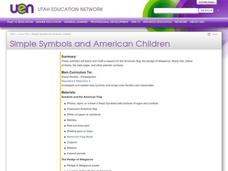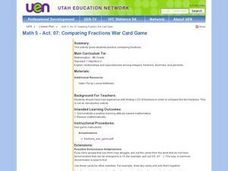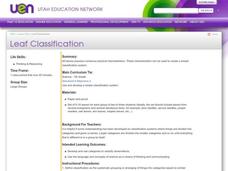Curated OER
Diet: Find the Carbohydrates
Students discover and discuss the functions of carbohydrates. Once they have taken notes and completed worksheets, they perform experiments using iodine to test for starch. Lesson topics include how carbohydrates are processed by the...
Curated OER
Clothing--Sewing Activities
Students are introduced to basic sewing activities. Individually, they practice creating seams, attaching a button, and ironing clothing. To end the instructional activity, they review correct sewing terminology and complete other...
Curated OER
Color - Interior Design
Students review the principle elements of design along with the sequence of colors on the color wheel. In groups, they assign a feeling or mood to each color and share it with the class. To end the instructional activity, they use the...
Curated OER
Questions or Statements?
Pupils are introduced to the six question words of who, what, when, where, why and how. After being read a story, they are asked who and what the story was about. To end the lesson, they practice identifying questions and statements.
Curated OER
Career: Writing Effective Resumes
Students complete sample job applications and develop resumes. In a hands-on activity, they use a magnetic fishing pole to retrieve paper fish with resume information written on them. The lesson also includes a Powerpoint...
Curated OER
Elements Video
Students watch a video on the elements of design. During the video, they take notes and complete a worksheet on the material. To end the lesson, they review their answers to the worksheet and view examples of each element of design in a...
Curated OER
Family Life Cycle
Learners review the food groups and their placement on the food pyramid. Using the internet, they research the nutritional guidelines for different age groups and compare them. To end the lesson, they identify reasons for choosing the...
Curated OER
Food Preservation
Students examine the variety of food preservation methods available today. In groups, they participate in an experiment to determine the conditions that encourage or stop the growth of bacteria. To end the lessons, they discuss the...
Curated OER
Handwashing and Sanitation
Learners apply Glo-Germ to their hands to see the amount of germs on their skin. As a class, they watch a demonstration on how to properly watch their hands to prevent the spread of disease. To end the lesson, they are introduced to the...
Curated OER
Diet: Soup and Salad Lab
Students prepare soup and salad meals and assess their nutritional and aesthetic values. After solving soup riddles and discussing types of salads, they use meal planning forms to list ingredients and recipe information. The lesson also...
Curated OER
Cyberspace Pursuit
Students are introduced to a variety of communications technology. Using the internet, they complete a Cyberspace worksheet in which they complete a variety of activities using the different types of technology. To end the lesson, they...
Curated OER
Hygiene Potato Graphs
Fifth graders discuss the importance of proper hygiene. After watching their teacher peel potatoes, they discuss why she was wearing rubber gloves. They demonstrate how to wash their hands properly and why one should never touch...
Curated OER
Child Care
High schoolers investigate Child Care Models: Head Start, Montessori, Behaviorist, Constructivist. They identify the types of childcare and applicable licensure standards and laws. Students play a jeopardy game covering all the...
Curated OER
FACS: Sanitation & Food - Support Services (HST)
Students discuss the importance of proper food handling and sanitation by workers to ensure health and wellness. After watching a demonstration, they discuss how importance hand washing is to stop the spread of disease. To end the...
Curated OER
Earth's Seasons
Sixth graders review the relationship between the Sun and the Earth. In groups, they use a globe and flashlights to show the shadows on the Earth during the different seasons. To end the instructional activity, they write in their...
Curated OER
Simple Symbols and American Children
Students are introduced to a variety of symbols representing the United States. As a class, they identify places in which they have seen the various symbols and discuss what they mean. To end the lesson, they state the words from the...
Curated OER
Clustering
Fifth graders are introduced to the concept of clustering. In groups, they use their new science vocabulary words to put into a web or cluster. To end the lesson, they read a book related to electricity and write the definitions of any...
Curated OER
Homonym Baseball
Sixth graders are introduced to the characteristics of homonyms. In groups, they are given points in the baseball game when the homonyms are matched to the correct definition. To end the lesson, they practice spelling the different...
Curated OER
Expanded Form and Place Value
Third graders are introduced to the concept of place value with place value tents. As a class, they are shown a number which they say outloud and write the number in expanded form. To end the lesson, they practice saying numbers in the...
Curated OER
Comparing Fractions War Card Game
Fifth graders participate in an exercise in which they practice using fractions. After reading a book, they review the rules of the game as a class. To end the instructional activity, they determine the lowest common denominator for...
Curated OER
Flicking With Force
Third graders are introduced to the concept of force and how it acts upon objects. In groups, they are given a ruler, ping-pong ball and golf ball and compare and contrast the force put on the balls when flicked by the ruler. To end...
Curated OER
How Big Are Earth, Sun, and Moon?
Third graders draw what they believe is in space on a dry erase board. In groups, they are given a beaker half filled with water and they add a teaspoon of oil, observing the different layers that form. To end the lesson, they identify...
Curated OER
Leaf Classification
Seventh graders work together to develop a leaf classification system. In groups, they are given a set of leaves and sort them based on their characteristics. They share their new classification system with the class and answer any...
Curated OER
Living or Nonliving
Third graders brainstorm a list of the characteristics of living and nonliving organisms. Individually, they find four nonliving and living items and the characteristics that make them fit into one of the categories. To end the lesson,...

























